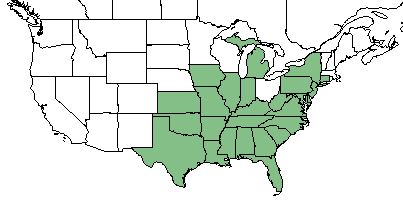Desmodium glabellum
Common Names: Ticktrefoil [1]; Smooth Beggarlice [2]; Tall Tick-trefoil [3]
| Desmodium glabellum | |
|---|---|
| Scientific classification | |
| Kingdom: | Plantae |
| Division: | Magnoliophyta - Flowering plants |
| Class: | Magnoliopsida - Dicots |
| Order: | Fabales |
| Family: | Fabaceae |
| Genus: | Desmodium |
| Species: | D. glabellum |
| Binomial name | |
| Desmodium glabellum (Michx.) | |

| |
| Natural range of Desmodium glabellum from USDA NRCS Plants Database. | |
Contents
Taxonomic Notes
Synonyms: Meibomia paniculata (Linnaeus) Kuntze; Meibomia pubens (Torrey & A. Gray) Rydberg; D. paniculatum (Linnaeus) A.P. de Candolle var. dillenii (Darlington) Isely
Varieties: none
Description
D. glabellum is a perennial forb/herb of the Fabaceae family native to North America. [1] It reaches heights between 2 1/2 to 5 feet at maturity. Flowers are pink or purple, irregularly shaped, and have no aroma; when spent, flowers turn blue. Leaves alternate, egg-shaped with little to no point, and composed of 3 entire leaflets. Where the leaf is attached to the stem, there is either little or no stipule. Fruit has hooked hairs for animal translocation.[4]
Distribution
The native distribution of D. glabellum is along hte United States east coast, west to Texas, Oklahoma, and Kansas. [1]
Ecology
Habitat
It can be found in its native distribution in woodland borders, fields, and other disturbed areas.[3] D. glabellum prefers slightly dry to dry conditions in partial sun; it can grow on soil that contains clay-loam, loam, or other rocky materials. Other habitats include savannas, rocky upland forests, limestone glades, and various thickets.[4]
Phenology
D. glabellum has been observed to flower between August and October, with peak inflorescence in September. [5] Fruit production is between August and October.[3]
Seed dispersal
D. glabellum is a member of the pea family. It's pea pods or seeds have tiny hooked hairs on the shell that make them ideal for sticking to passing fur bearing animals for dispersal.[1] This species is thought to be dispersed by translocation on animal fur or feathers. [6]
Seed bank and germination
Firm seedbed is required for germination to be successful.[4]
Pollination
The primary pollinators of D. glabellum are long tongued bees.[4]
Use by animals
Seeds from D. glabellum are eaten by birds and upland game birds, rodents, wild turkey, rabbits, groundhogs, livestock, and deer. [4]
Diseases and parasites
White mold has been observed to grow on D. glabellum. Adult Japanese beetles will feed on the plant's flowers and leaves. [4]
Conservation and Management
D. glabellum has been placed on the special concern list for the state of Connecticut. [1] For management, disking and harrowing followed by cultipacking is a good method for establishing a good clean and firm seedbed for D. glabellum. As well, planting in no-till conditions can also be effective if weeds are controlled prior to planting seeds as well as managing residue.[4]
Cultivation and restoration
Photo Gallery
References and notes
- ↑ 1.0 1.1 1.2 1.3 1.4 USDA Plant Database
- ↑ Davis, J., J. Eric, et al. (2002). "Vascular flora of Piedmont Prairies: Evidence from several prairie remnants." Castanea 67(1): 1-12.
- ↑ 3.0 3.1 3.2 Weakley, A. S. (2015). Flora of the Southern and Mid-Atlantic States. Chapel Hill, NC, University of North Carolina Herbarium.
- ↑ 4.0 4.1 4.2 4.3 4.4 4.5 4.6 Leif, J. W. (2009). Plant Fact Sheet: Dillenius' Tick-trefoil Desmodium glabellum. N.R.C.S. United States Department of Agriculture. Rose Lake Plant Materials Center, East Lansing, MI.
- ↑ Nelson, G. PanFlora: Plant data for the eastern United States with emphasis on the Southeastern Coastal Plains, Florida, and the Florida Panhandle. www.gilnelson.com/PanFlora/ Accessed: 21 MAY 2018
- ↑ Kirkman, L. Katherine. Unpublished database of seed dispersal mode of plants found in Coastal Plain longleaf pine-grasslands of the Jones Ecological Research Center, Georgia.